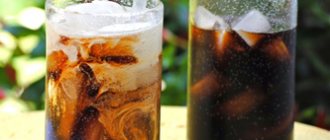Cold coffee is very refreshing and tonic. There are many variations of this drink. Some are prepared using the classic method of brewing crushed grains, while others use a method of extracting active substances in ice water. Most people drink this coffee only in the warmer months.
Cold coffee on a hot day will invigorate the body.
For iced coffee, choose your water carefully
Often when preparing coffee, many people get hung up on the choice of beans, but the drink mainly consists of water, and it has a significant impact on the taste.
Making the perfect cup of iced coffee requires soft, delicious water. Hard water is not needed for coffee; it contains too many salts, mainly calcium and magnesium, which “kill” the natural taste of the beans. And too alkaline water also reduces the sourness of coffee, so beloved by many.
Baristas are advised to use water with a mineralization of 75 to 175 mg/l, preferably 100 mg/l, and a calcium content of 51-68 mg/l and sodium content of 10 mg/l. If you have the opportunity to find out the pH (the balance between acidity and alkalinity), pay attention to this indicator too! It is optimal when the pH level is from 6.5 to 8. And also, avoid chlorine! Coffee is not needed at all, that is, it is absolutely contraindicated.
May reduce the risk of developing Parkinson's and Alzheimer's disease
In addition to improving your focus and mood, iced coffee can benefit your brain in other ways.
Caffeine stimulates your nervous system and can affect your brain function.
One recent study found that drinking coffee may protect your brain from age-related diseases ().
Alzheimer's and Parkinson's diseases are neurodegenerative diseases - meaning that they are caused by the death of brain cells that occurs over time. Both diseases can lead to dementia, a weakness that makes everyday activities difficult.
Alzheimer's disease is characterized by significant memory loss, while Parkinson's disease often causes physical tremors and stiffness ().
One observational study found that people who drank 3–5 cups of coffee a day in midlife had a 65% lower risk of developing dementia and Alzheimer's disease later in life ().
Another observational study noted that coffee drinkers had a lower risk of developing Parkinson's disease. In fact, men who drink more than four cups of coffee a day are five times less likely to develop this disease (,).
It appears that some compounds in coffee, such as phenylindanes and the compounds harmane and non-garmane, provide protection against Alzheimer's and Parkinson's disease (, , , ).
Keep in mind that decaffeinated coffee does not have the same protective properties as caffeinated coffee ().
Summary:
Cold brew coffee contains compounds called phenylindanes, as well as lower amounts of harmane and non-garmane compounds. These compounds may help protect your brain from age-related diseases.
Dissolve sugar completely when making iced coffee
Many people love iced coffee black and sometimes treat themselves by adding sugar (including vanilla or cinnamon). However, when the coffee is too cold, the sugar (and neither does the nut milk, by the way) doesn't dissolve, resulting in a grainy, powdery drink. What sadness!
It is best to add simple sugar syrup rather than sugar (see the recipe for Cold Coffee Lemonade at the end of the material for how to do this). You can prepare 200-300 ml of syrup at a time and store it in the refrigerator. The syrup can be mixed with coffee, or with milk and then added to coffee. And of course, no one forbids sweetening a hot drink so that the sugar is completely dissolved, and therefore cooling the coffee.
What is nitro coffee
This drink is coffee brewed with nitrogen.
(literally). Coffee is placed in a beer barrel and served in a glass.
The drink takes on a creamier and sweeter taste.
When you pour a glass of chilled nitro coffee, you get what looks like a shot of beer with a foamy head.
This drink cannot be mixed
with milk or ice, otherwise it will simply cease to be nitro coffee. For this, some bars in the West can even make you persona non grata.
How to make iced coffee
Now let's figure out why cold brew is healthier than hot coffee.
Learn how to cool coffee properly
The problem is that to make the perfect iced coffee, it's important to not only brew it, but also to cool it. Of course, you can simply add ice to hot coffee, leave it on the table and wait for the ice cubes to do their job, but it often turns out that such a drink will not have the desired taste.
One strategy recommended by experts is to use a cocktail shaker. Your family might be surprised to see you vigorously shaking a shaker at 7 a.m., but let them get used to it—it's the fastest way to cool down your iced coffee. Simply pour freshly brewed hot coffee into the shaker, add ice cubes, and then shake the contents of the shaker.
Iced coffee
Literally translated – ice coffee. A group of drinks based on cold coffee, to which a variety of “taste improvers” are added: milk, cream, syrups, chocolate, etc. To cool ice coffee, you can use ice or put hot coffee in the refrigerator.
Ingredients:
- black coffee – 50 ml;
- cold milk – 100 ml;
- cream – 40 g;
- ice – 3-4 cubes (optional);
- sugar, grated chocolate, cinnamon - to taste.
Don't make boring iced coffee
There are many ways to customize your iced coffee flavor to suit your mood, occasion, or just to experiment, so get creative!
- Adding almond milk will give your coffee a sweet, nutty flavor and cover up the bitterness (if desired).
- If you're a coconut fan, try coconut milk for a smooth finish.
- Season your coffee with a pinch of nutmeg or cinnamon (ground or by dropping a cinnamon stick into the cup).
- Adding lavender, basil and mint to iced coffee is so summery.
- Add berries, seasonal fruits, or syrups based on them to your iced coffee to suit your taste.
More caffeine
Thanks to the long brewing process
The ratio of coffee and water in the drink is approximately 1:60. In regular coffee this figure is about 1:20.
However, remember
that some people dilute this drink with milk, cream or water, which reduces the caffeine concentration. In addition, there are several factors to consider:
• the coffee beans you use
• the total time you brew the coffee
• how much milk, cream or water you use to dilute the drink.
A regular French press (500 ml) in which you brew cold brew contains about 200 mg of caffeine.
Try an alternative way to make iced coffee
Most often, iced coffee is a freshly brewed hot drink that is cooled by ice. But not only! There is another option. Coarsely ground coffee is steeped in room temperature drinking water or cold water for 12–24 hours. It tastes very similar to classic iced coffee, but without the bitter aftertaste.
Baristas said that the main reason why this method is now gaining popularity is that this method produces easy-to-drink coffee, with low acidity and a pleasant chocolate consistency. Since the brewing time in this case is quite long, a very coarse grind is required and it is best to brew coffee in a French press.
May reduce the risk of developing type 2 diabetes
Type 2 diabetes is a chronic disease in which blood sugar levels are too high. If left untreated, this disease can lead to many serious complications.
Drinking iced coffee may reduce your risk of developing this disease. In fact, drinking at least 4 to 6 cups of coffee per day is associated with a lower risk of developing type 2 diabetes ().
This beneficial property may be largely due to the chlorogenic acids present in coffee, which are powerful antioxidants ().
Cold brew coffee can also regulate gut peptides, which are hormones in your digestive system that control and slow digestion and keep blood sugar levels stable (,).
One study of 36,900 people aged 45–74 found that those who drank at least 4 cups of coffee per day had a 30% lower risk of developing type 2 diabetes than people who did not drink coffee daily ().
A review of three large studies of more than 1 million people found that those who increased their coffee consumption over 4 years had an 11% lower risk of developing type 2 diabetes, compared with a 17% higher risk. in those who reduced their coffee consumption by more than 1 cup per day ().
Summary:
Drinking iced coffee regularly will help keep your blood sugar levels stable and reduce your risk of developing type 2 diabetes.
BONUS! Iced Coffee Lemonade Recipe
Cold coffee lemonade
To prepare approximately 1.3 liters of drink you need:
- 400 ml cold black coffee
- 250 ml freshly squeezed lemon juice (about 2.5 large lemons)
- 500 ml tonic
- ice cubes
- lemon or orange slices for garnish
For the syrup:
- 160-170 g sugar
- zest of 1 lemon
- 200 ml drinking water
- Start with the syrup. Pour sugar into a saucepan, add lemon zest, and add water.
- Bring the mixture to a boil and simmer until the sugar crystals dissolve.
- Strain, cool and refrigerate for 1 hour.
- Combine strong coffee with 250 ml of syrup and lemon juice in a carafe and stir. Top up with tonic.
- Serve over ice and garnish with citrus slices.
Frappe
This iced coffee recipe was invented by Nestle employee Dimitris Vakondios in 1979. Frappe is now considered the national drink of Greece. For preparation, powdered or granulated instant coffee is used, which, due to the minimum concentration of oils, produces a “signature” fluffy foam. There are two varieties: classic - water-based and milky - with milk.
Ingredients:
- instant coffee – 2 teaspoons;
- sugar – 1-2 teaspoons;
- water or milk – 100 ml;
- crushed ice;
- vanilla, cinnamon, grated chocolate - to taste.
Recipe
1. Mix instant coffee and sugar in a deep bowl. Add 2 tablespoons of water.
2. Beat the mixture with a mixer or other method until a fluffy foam appears.
3. Fill the serving glass with ice. Pour in the coffee foam.
4. Add water or milk. Mix. Serve with a straw.
History and composition
Greek coffee Frappe is considered one of the first soft coffee drinks. In 1957, an employee of the Swiss company Nestle mixed coffee powder, milk powder and cold water in a shaker. The resulting drink was appreciated and became the hallmark of Greece.
Greek Frappe has several methods of preparation, differing primarily in composition:
- To enhance the taste, add cherries to coffee;
- in other variations, milk is replaced with ice cream, which gives the coffee a pleasant creamy taste;
- add chocolate, nuts, cream, cinnamon, various syrups and liqueurs.
Milkshake with coffee
A coffee milkshake or an Espresso milkshake is very easy to prepare: any milkshake is prepared with milk and ice cream. You can add berries and/or fruits and mix it all with a blender. If you add espresso or double espresso to the drink, you get a coffee milkshake.
How to make a coffee milkshake
You will need:
- Ice cream
- Milk
- Fruits and/or berries (optional)
- Blender
- Coffee.
- Mix a portion of ice cream, milk and fruits/berries in a blender.
- Pour everything into a glass and add espresso.
Coffee milkshake (video)
Frappe - chilled in crushed ice
Although the name of this thick, milky foam-covered cold coffee cocktail with ice cream and fruit syrup was born in France, its recipe is more popular in sunny Greece and Cyprus.
- Using 200 ml of filtered water and 2-3 tsp. ground beans, brew espresso.
- Cool smoothly and pour into a blender.
- Add ¼ cup milk, a few ice crystals; sweeten 2-3 tsp. Sahara.
- Blend until the ice “melts” into coarse snow, usually about 10 seconds.
- It's time for additives: it can be vanilla, fruit or chocolate topping. Add them to the already prepared mass and mix again until smooth.
- Pour into a tall glass, garnish with a swirl of whipped cream, grab a straw and enjoy!
New for the season
Those who like to accompany friendly conversations with original desserts will really like this “cold” new product from McDonald’s.
Their recipe for relief from the heat is based on a mixture of Arabica and Robusta (80% and 20%, respectively), water, food ice, and vanilla syrup. The delicate, subtle bouquet and pronounced sweetness of the latter well masks the bitterness that the presence of robusta gives to the drink.
The chain’s new product is loved not only by those with a sweet tooth, but also by all coffee fans who want to escape the summer heat.
The ABC of taste and freshness
A cooling drink loses almost all its aroma, the most important component of its taste. Our brain “identifies” different tastes by simultaneously receiving signals from receptors in the mouth and nose.
How to make coffee without losing its taste?
Professional coffee makers solve this problem by preferring light roasted beans and choosing the fastest brewing methods (for example, Australian Lungo). Next, the drink is cooled smoothly at room temperature, and only after that is put in the refrigerator.
How to make iced coffee at home? If you don’t have a coffee machine, you should use strong “varieties” of the drink as a basis, since adding ice somewhat “softens” the coffee. Espresso and traditional “Turkish” coffee are best suited. To prepare the latter, ground grains are brought to a boil in a Turk 2-3 times, but do not boil. The sediment remaining after brewing the beans must be decanted.











